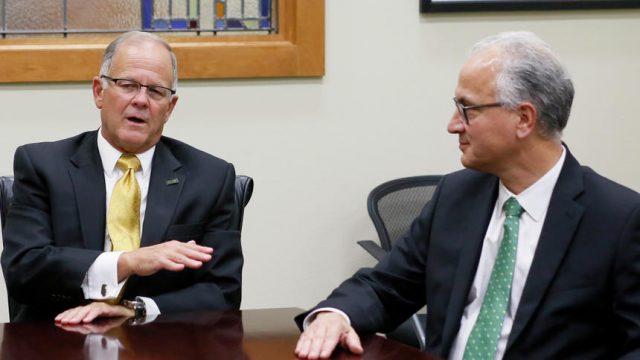The Magical Thinking Behind Dumping Money Into Higher Education

North Dakota State University President Dean Bresciani, left, and University of North Dakota President Mark Kennedy meet with The Forum Editorial Board to make the case for more legislative funding for research Wednesday, Sept. 12, 2018, in Fargo. Michael Vosburg / Forum Photo Editor
It was illuminating, I think, that the recent headline to a Fargo Forum editorial supporting a proposal to dump more taxpayer dollars into UND and NDSU was “Create brighter future for UND, NDSU.”
It was not “Create brighter future for North Dakota students” or “Create brighter future for North Dakotans” but rather “Create brighter future” for two massive government institutions which drive a lot of commerce for cities like Fargo and Grand Forks.
The editorial backs a proposal from UND President Mark Kennedy, and NDSU President Dean Bresciani, which would see the state make a massive funding commitment to their universities for research. Possibly using the Legacy Fund as a funding source.
You’ve probably read about this proposal before, and if we cut through all the hyperbole and buzzwords, all it really amounts to is the leaders of a couple of institutions with declining enrollment making a pitch for more money.
There’s nothing particularly visionary about it, though the Forum editorial attempts to manufacture that perception:
Legislators in North Dakota have yet to wake up to the fact that the state finds itself caught in the natural resource trap. States and nations that derive their wealth from natural resources often fall into complacency and fail to innovate. In time, the world passes them by. North Dakota, unfortunately, finds itself on that dreary trajectory.
But the presidents of North Dakota State University and the University of North Dakota are offering a bold alternative. The two flagship universities provide important economic engines through the research they perform. NDSU President Dean Bresciani and UND President Mark Kennedy are making the case for an initiative that would provide $100 million over a four-year period to the two universities, to be divided equally, to fund promising research. To thrive, research universities should have a solid and predictable funding base to enable them to do both basic and applied research that will drive innovation and economic vitality. Unfortunately, North Dakota has neglected to provide significant financial support for its research universities outside of sustained support for agricultural research.
North Dakota’s homogeneous economy, which is too reliant on commodity-driven industries, is absolutely a real problem. But the idea that we’re going to solve that problem, or even mitigate it in any meaningful way, by pouring more money into these universities smacks of magical thinking.
Something akin to Republicans believing that every tax cut pays for itself, or Democrats believing the solution to our expensive and bureaucracy-addled health care industry is more expensive bureaucracy.
Sometimes the things we want to be true just aren’t.
It is true that campuses like UND and NDSU are economic engines, but most of their direct economic impact is in the form of students doing things like ordering pizza and buying beer.
The people drawn to communities like Fargo and Grand Forks to work at and attend universities like NDSU and UND drive a lot of commerce. That’s great. For Fargo and Grand Forks.
There’s a lot of education which happens at the universities, and that’s great too. Where our primary focus should be, in fact. Yet it often seems as though higher education leadership, not to mention their boosters in the local media, are more concerned about packing as many students and tax dollars into their institutions as possible on the assumption that what will spew out the other side is a well-trained workforce.
This isn’t the case. Universities are not factories. Students are not widgets.
I am very much in favor of initiatives aimed at diversifying North Dakota’s economy. I’m not even opposed to those initiatives including our state’s institutions of higher education. What I am not for is pouring money onto the heads of bureaucrats motivated by the wrong priorities.




